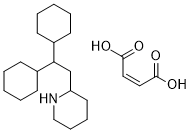| Cas No.: | 6724-53-4 |
| Chemical Name: | PERHEXILINE MALEATE |
| Synonyms: | PERHEXILINE MALEATE ;rac Perhexiline Maleate;(Z)-but-2-enedioic acid,2-(2,2-dicyclohexylethyl)piperidine;PERHEXILINE MALEATE;PERHEXILINE MALEATE SALT;rac Perhexiline Male;2-(2,2-Dicyclohexylethyl)piperidine maleate;DSSTox_CID_1114;EINECS 229-775-5;perhexilene maleate;Perhexiline maleate (USAN);perhexilline maleate;Pexid;2-(2,2-Dicyclohexylethyl)piperidine |
| SMILES: | OC(/C=C\C(=O)O)=O.C1CCC(CC(C2CCCCC2)C2CCCCC2)NC1 |
| Formula: | C23H39NO4 |
| M.Wt: | 393.560067415237 |
| Purity: | >98% |
| Sotrage: | 2 years -20°C Powder, 2 weeks 4°C in DMSO, 6 months -80°C in DMSO |
| Description: | Perhexiline maleate is a potent carnitine palmitoyltransferase 1 (CPT 1) inhibitor with IC50s of 77 and 148 μM for rat heart and liver CPT 1, respectively. |
| Target: | IC50: 77 μM (Rat heart CPT 1), 148 μM (Rat liver CPT 1)[1] |
| In Vivo: | The co-administration of Perhexiline and cisplatin yields a clear enhancement of antitumor effects, resulting in a significantly improved progression-free survival as compared with mice treated with DMSO. Perhexiline favors NB cell transition to differentiated phenotype[2]. |
| In Vitro: | At 24, 48 and 72 h of treatment with 0.01 and 1 μM of Perhexiline , NDM29 ncRNA expression level in SH-SY5Y cells is progressively increased, reaching a peak after 48 hours of treatment. Perhexiline treatment increases the susceptibility of NB cells to antiblastic treatments. Co-administration of Perhexiline maleate potentiates the efficacy of cisplatin to reduce the in vitro clonogenic potential of NB cells[2]. |
| Cell Assay: | The effect of antitumoral drugs on neuroblastoma cell survival is evaluated using the MTT assay. Approximately 24 hours after plating, cells are exposed to Perhexiline maleate (0.01 μM) for 48 hours at 37°C. Cytotoxicity is expressed as the percentage of cells surviving in relation to untreated cells[2]. |
| Animal Administration: | Mice: In protocol a, 21 mice are divided in 4 groups: control vehicle group: DMSO; cisplatin (3 mg/kg/dose) treated group; Perhexiline (1 mg/kg/dose) treated group and; Perhexiline (1 mg/kg/dose) and cisplatin (3 mg/kg/dose) treated group. In protocol b, 20 mice are divided in 4 groups: control vehicle group: DMSO; Perhexiline (3 mg/kg/dose) treated group; cisplatin (5 mg/kg/dose) treated group; Perhexiline (3 mg/kg/dose) and cisplatin (5 mg/kg/dose) treated group[2]. |
| References: | [1]. Kennedy JA, et al. Inhibition of carnitine palmitoyltransferase-1 in rat heart and liver by Perhexiline and amiodarone. Biochem Pharmacol. 1996 Jul 26;52(2):273-80. [2]. Vella S, et al. Perhexiline maleate enhances antitumor efficacy of cisplatin in neuroblastoma by inducing over-expression of NDM29 ncRNA. Sci Rep. 2015 Dec 17;5:18144. |

 DC Chemicals' products qualify for U.S. tariff exemptions. We guarantee no price increases due to customs duties and maintain stable supply, continuing to deliver reliable research solutions to our American clients.
DC Chemicals' products qualify for U.S. tariff exemptions. We guarantee no price increases due to customs duties and maintain stable supply, continuing to deliver reliable research solutions to our American clients.





















